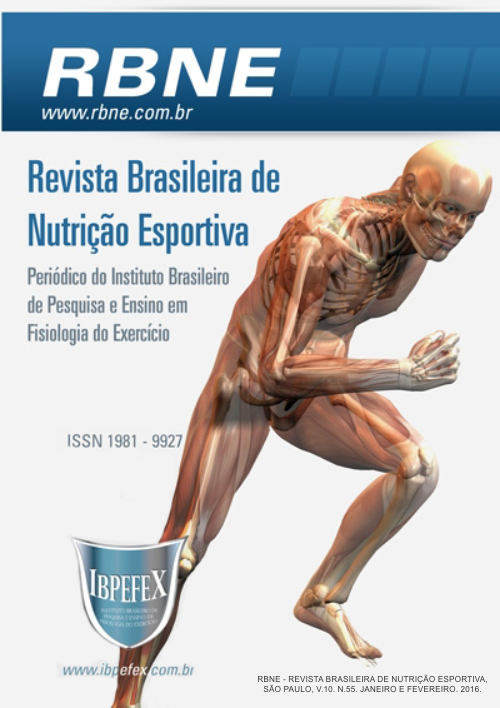Effects of creatine supplementation on neuromuscular training and body composition in youth and elders
Abstract
Introduction: Over the time, it has been intensified the necessity of solutions to minimize and to avoid these alterations occasioned by the aging. The force training applied either in youth or in elders has been recommended as a safe and efficient intervention because the benefits on increasing the resistance, the muscle mass and the willingness to practice physical activities are being reached through the association of using creatine supplementation. Aim: Evaluate modifications on the body performance inyouth and elders through the application of a neuromuscular training program with and without the use of creatine. Materials and Methods: The research was applied with 22 youth (group A) with age between 18 and 25 years and 20 elders (group B) with age between 60 and 70 years. Both groups were oriented by a nutritionist. The data analysis was determined through the T test compiled to a sample as the data presented normal distribution with statistic significance equal less than 0, 05. Results: The mass freeof fat was significantly increased on the supplemented group (4, 23%) and on the group without supplementation (2, 15%). The percentage of fatness did not present significant difference; however the body mass reached visible difference only in the supplemented group. Conclusion: The supplementation of creatine presents possible and effective contributions to the health if it is connected to the neuromuscular training over men and women (youth and elders) The use of creatine associated to the force trainingcan be interrelated to elders and youth in order to minimize the effects of aging as it has contributed to the increase of performance in multiple series with less repetitions during the process of training.
References
-Aagaard, P. Making Muscles “Stronger”: Exercise, Nutrition, Drugs. J Musculoskel Neuron Interact. Vol. 4 Num. 2. 2004. p. 165-174.
-Branch, J. D. Effect of Creatine Supplementation on Body Composition and Performance: A Meta-Analysis. International Journal of Sport Nutrition and Exercise Metabolism. Vol.13. 2003. p. 198-226.
-Dias, A. C.; Fazolo, E.; Morgado, J. J. M.; Pimentel, P.A.; Dantas, E.H.M. Efeitos da Ingestão de Creatina na Composição Corporal e na Performance do Exercício Supino. Fitness & Performance Journal. Rio de Janeiro. Vol. 2. Núm. 5. p. 270-274. 2003.
-Gualano, B.; Acquesta, F.M.; Ugrinowitsch, C.; Tricoli, V.; Serrão, J.C.; Lancha Junior, A.H.L. Efeitos da Suplementação de Creatina Sobre Força e Hipertrofia Muscular: Atualizações. Revista Brasileira de Medicina do Esporte. Niterói. Vol. 16. Núm. 3. 2010.
-Gilson, S.F.; Saunders, M. J.; Moran, C.W.; Moore, R.W.; Womack, C.J.; Todd, M.K. Effects of Chocolate Milk Consumption on Markers of Muscle Recovery Following Soccer Training: a Randomized Cross-Over Study.Journalof International Societyof Sports Nutrition. Vol. 7. Num. 19. 2010.
-Kerksick, C.M.; Rasmussen, C.; Lancaster, S.; Starks, M.; Smith, P.; Melton, C.; Greenwood, M.; Almada, A.; Kreider, R. Impact of Differing Protein Sources and a Creatine. 2007.
-Nobrega, A.C.L.; Freitas, E.V.; Oliveira, M.A.B; Leitao, M.B.; Lazzoli, J.K.; Nahas, R.M.; e colaboradores. Posicionamento Oficial da Sociedade Brasileira de Medicina do Esporte e da Sociedade Brasileira de Geriatria e Gerontologia; Atividade Física e Saúde no Idoso. Revista Brasileira de Medicina do Esporte. Vol. 5. Núm. 6. p. 207-211. 1999.
-Okuma, S.S. O idoso e a atividade física: Campinas; Papirus, 2002.
-Petroski, E. L. Desenvolvimento e validação de equações generalizadas para a estimativa da densidade corporal em adultos. Tese de Doutorado em Educação Física. Santa Maria. Centro de Educação Física e Desportos, Universidade Federal de Santa Maria. 1995.
-SouzaJúnior, J. R.; Dubas. J.P.; Pereira. J.B.; Oliveira, P.R. Suplementação com creatina e exercício físico. Revista Treinamento Desportivo. Vol. 8. Núm. 1 p. 65-70. 2007.
-Volek, J. S.; Rawson, E. S. Scientific Basis and Practical Aspects of Creatine Supplementation for Athletes. Nutrition. United States. Vol. 20. Num. 7/8. p. 609-614. 2004.
-Tessmer, C. S.; Silva, M. C.; Pinho, M. N.; Gazalle, F. K.; Fassa, A. G. Insatisfação Corporal em Frequentadores de Academia. Revista Brasileira de Ciência e Movimento. Vol. 14. Núm. 1. p. 7-12. 2006.
Authors who publish in this journal agree to the following terms:
- Authors retain the copyright and grant the journal the right of first publication, with work simultaneously licensed under the Creative Commons Attribution License BY-NC which allows the sharing of the work with acknowledgment of the authorship of the work and initial publication in this journal.
- Authors are authorized to enter into additional contracts separately for non-exclusive distribution of the version of the work published in this journal (eg, publishing in institutional repository or book chapter), with acknowledgment of authorship and initial publication in this journal.
- Authors are allowed and encouraged to post and distribute their work online (eg, in institutional repositories or on their personal page) at any point before or during the editorial process, as this can bring about productive change as well as increase impact and impact. citation of published work (See The Effect of Free Access).






